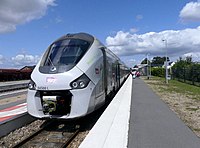
Photo from wikipedia
In anaerobic digesters (AD), volatile fatty acids (VFAs) concentration is a critical operative parameter, which is usually manually monitored to prevent inhibition of microbial consortia. An on-line VFAs monitoring system… Click to show full abstract
In anaerobic digesters (AD), volatile fatty acids (VFAs) concentration is a critical operative parameter, which is usually manually monitored to prevent inhibition of microbial consortia. An on-line VFAs monitoring system as early-warning for increasing concentrations would be of great help for operators. Here, air-cathode membraneless microbial fuel cells (MFCs) were investigated as potential biosensors, whose electrical signal instantaneously moves from its steady value with the accumulation of VFAs in the anodic solution. MFCs were operated equipping four lab-scale ADs with carbon-based electrodes. Reactors were filled with the digestate from a full-scale AD and fed in batch with four kinds of feedstock (cheese whey, kitchen waste, citrus pulp and fishery waste). The MFC signal initially increased in parallel to VFAs production, then tended to a steady value for VFAs concentrations above 1000mgAcL-1. Peak concentrations of tVFAs (2500-4500mgAcL-1) and MFCs potentials were negatively correlated (r=0.916, p<0.05), regardless of the type of substrate. Inhibition of the MFC system occurred when VFAs increased fast above 4000mgAcL-1. Polarization curves of electrodes stressed that electroactive bacteria on bioanodes were strongly subjected to inhibition. The inhibition of electroactivity on bioanode trended like typical shock-sensors, opening to direct application as early-warning monitoring system in full-scale ADs.
Journal Title: Waste management
Year Published: 2018
Link to full text (if available)
Share on Social Media: Sign Up to like & get
recommendations!